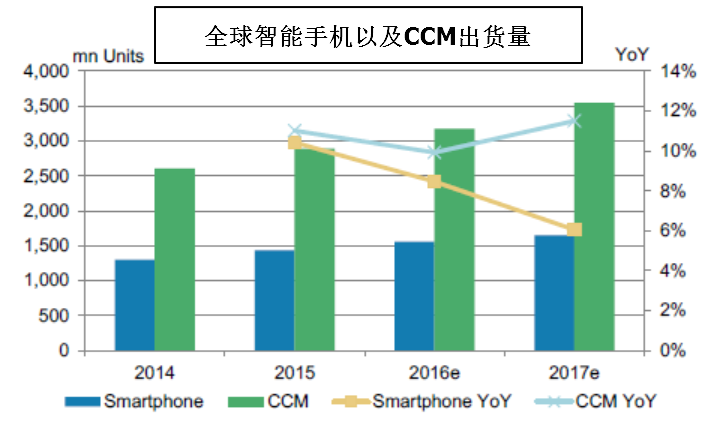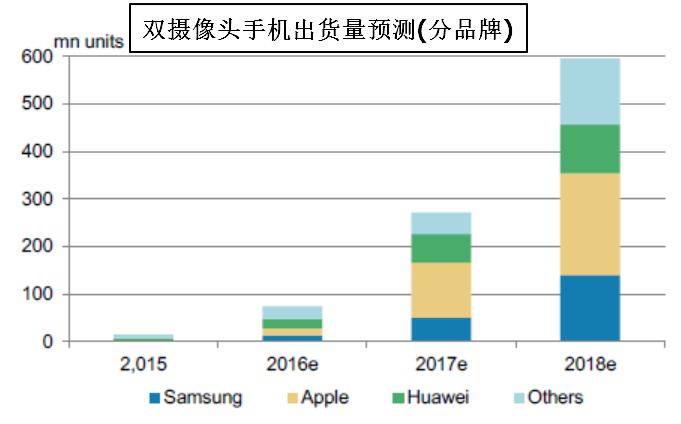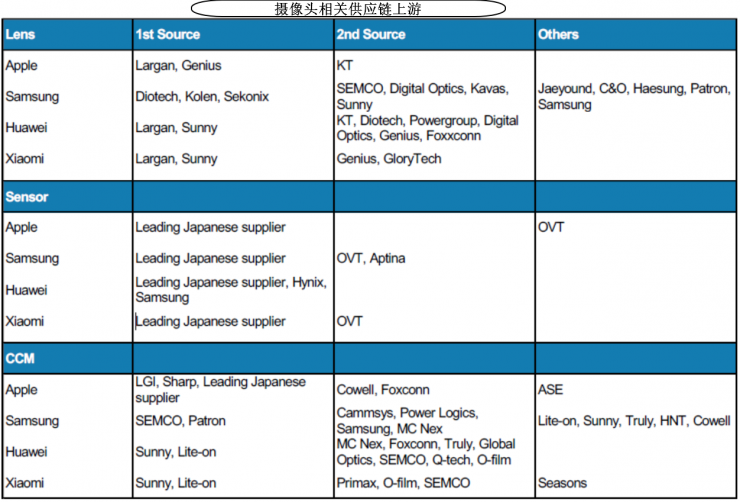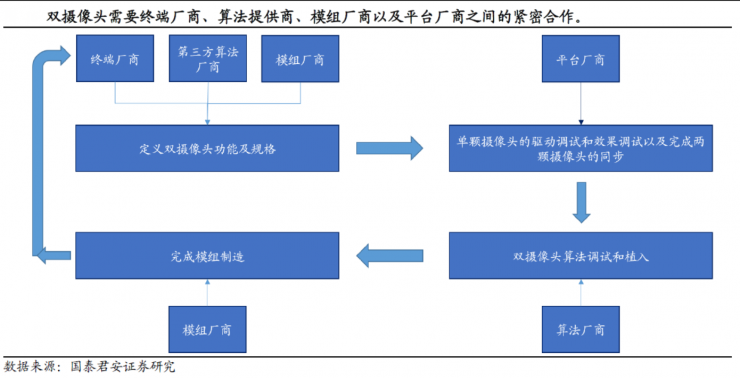The mobile phone camera industry chain company was abandoned by the market before the concept of AR/VR came out last year. One of the most important logic is that the growth rate of the company’s revenue in the camera industry chain caused by the decline in the growth rate of smartphone shipments also increases. Falling, even facing rumors of shuffling. However, the penetration rate of some VR hardware and car-assisted driving systems began to gradually eliminate doubts from investors last year, but due to the slow volume of VR and the low efficiency and high demand of the camera into the car main engine plant, it is short-term for the camera industry. The chain does not achieve a significant boost. Every time the market is eager to try, but every time they are hit by reality.

but! Now Apple's dual cameras on behalf of the mobile phone host factory door began to move really (in fact, high pixels can not play, for a tactic), iPhone 7 Plus's post-binocular camera is opened for everyone to look forward to dual purpose In the end, I can't guarantee a 50% penetration rate of new machine sales, but I can be sure that the next 2-3 years will be a year for the camera to accelerate again.
| Why is Apple iPhone 7 Plus? !

It is well known that before Apple, both the hTC in 2014 and Huawei in 2015 were equipped with dual cameras, but why did Apple detonate the market? But now the answer is very simple. HTC M8 sold 8 million units in the current month, and Huawei P9 sold 6 million units in six weeks. However, Apple's first week of sales must be tens of millions of dollars, plus the market expects to ship iPhone 7/7 Plus this year will be around 65 million units, 200 million next year, if you follow the previous iPhone 6 : 6 Plus = 4:1 relationship, iPhone 7 Plus will ship 15 million units this year and 40 million next year. In other words, a faint apple can at least increase the demand for cameras for this year by 1% and next year's shipment by 3.3%. In addition, the camera of hTC M8 at that time still remained at 4 million pixels, which did not meet the general demand at that time. The author of the original hTC is also a fanatic enthusiast, but later found hTC M8 dual camera is neither anti-shake nor particularly clear, it is just fun, such as adjusting the focus, 3D effects. At the beginning of the year, I also thought of starting Huawei P9, but after research, I found that although they use 12 million pixel camera, but in fact only one camera is used for photography, the other is used to capture details, not There will be 3D and zoom capabilities, that is to say, a realist or art school, apparently the author is not. At present, it seems that the iPhone's post eyes should be a combination of HTC M8 and Huawei P7 features, so it can attract more people to use, but to tell the truth, the appeal of the iPhone itself is strong enough.
| Rear binocular camera will be a trend
Pixel Bottleneck: If you can't upgrade the camera's photoreceptor surface in a large scale, dramatically increase the camera's pixels will lead to a decline in its photosensitivity and affect the picture quality of the phone's camera. This is why the Samsung S7 did not choose the 16 million pixels and chose the 12 million pixel + Dual Pixel solution.

Thickness limit : In general, the more the lens of the camera, the better the imaging quality, but this also directly affects the thickness of the mobile phone. Why does the iPhone 6 start to protrude from the camera? This is the reason.

If smartphones are to quickly get rid of the relevant restrictions, binocular cameras are currently a more secure choice. In other words, regardless of high-end or mid-to-low-end computers, every innovation is required to enhance the functions. Currently, the flagship models of the brand on the market are equipped with higher camera configurations. If they need to be further improved, then the best option is to use them. With binoculars. Of course, if only the flagship model has related improvements, personally think that the penetration rate of binocular cameras can only be about 30%-40%. In other words, if the following figure is accurate, the dual-camera driver will end in 2018.

For the entire mobile phone camera industry, not only the increase in shipments, but also the price increase, the following is a split image of the iPhone camera material cost:

For pure camera suppliers, the actual dual-target price will be about 20-30% higher than the monocular price (per camera price), so the camera manufacturer's revenue increase will be between 30-50%. Receive angle). In addition to the unexpected increase in camera costs, the processing costs of processing are also rising. The cost of the assembly of each camera module in the iPhone 7 Series will increase by 50%. For the entire cell phone camera module, in addition to the pure lens, the need to consider is the needs of the sensor and camera module (CCM) market, where the supplier of the Sensor is too centralized and the logic is simpler and cruder (that is, increase the installation of the sensor, It is very simple to bring about the increase in shipments, ASP will not rise), so we will not discuss it separately. In addition, today after talking to related industry professionals, he believes that the actual cost of the iPhone 7 Plus is to be $ 40 - two 12 million pixel modules: one for the telephoto lens, and the other for the imaging function The wide-angle lens can not only achieve twice the lossless optical zoom effect, but also can complete 10 times the digital zoom and background blur and other imaging effects.
Then it needs to focus on the production of the module, because the binocular camera changes the structure of the original monocular camera. The module factories that Apple and Samsung have cooperated with are mostly Japanese and South Korean companies, and the general business is more complex, so it is not a very reasonable target from an investment point of view. In general, a good target needs a relatively single business, so that the stock price/market value elasticity will be large. However, when we saw the Chinese companies Huawei and Xiaomi, it was obvious that the first supplier of the module was Sunny Optical. With the popularity of the binocular cameras made in China, Ophelia’s performance will increase accordingly. BTW, Sunny Optical itself has been deployed in the automotive camera field, so it can be said that Sunny Drive is dual-core.

Under the premise of dual cameras, there will be some changes in the industry chain. There is a need for a close cooperation and process between OEMs, algorithm providers, module manufacturers, and platform manufacturers. The general process is as follows: Show.
The core competitiveness of the camera in the future will shift from core components to algorithms . At this stage, we are more concerned about the process of the binocular camera in the module.

The main reason for the higher manufacturing process requirements of the current binocular camera module is the low yield and high cost caused by the placement problem of the two cameras. The coaxiality of the two cameras is extremely high. Only by reducing the overlap of the two cameras to 0.1 degree and the distance accuracy within 0.005 millimeters can the photos be well integrated by the algorithm. In order to ensure the coaxiality of the dual camera, the traces from the circuit board, VCM motor selection, camera base design, process flow and packaging process must be improved. According to the monarch’s calculations, the capital required to complete the 1KK/month dual camera production required to invest in AA equipment is as high as 64 million yuan (the monthly production capacity of Dachang is about 10KK/month). The quotations are as follows:
“Dual camera module manufacturing investment is relatively large and requires strong financial strength. The manufacture of dual-AF or ZOOM dual-camera modules requires high-precision packaging equipment such as six-axis AA equipment, calibration equipment, etc. Equipment, you can choose ASM, Pioneer, Hyvision, Kasalis and other manufacturers of equipment, the market price of about 2 million yuan each, the output efficiency of a single device is about 120 / hour, according to this simple inference of the highest production of dual cameras Above 60 pcs/hour, 20 hours in one day, 26 days in January, 1K/month dual camera production capacity required to invest 32 units in AA equipment, and funds up to 64 million yuan ."
Different binocular camera assembly methods have different advantages and disadvantages, and now the dual purpose assembly is mainly divided into whether the common substrate and the length of the optical axis spacing: long distance and short distance is the distance between the two cameras, like Iphone 7 Plus binocular The camera is a short-range camera. Whether it is a common substrate is whether the two cameras use the same substrate connection (the yellow underline in the figure shows the substrate). If it is not a common substrate, it usually needs a bracket to connect two cameras. Together, that is, the binocular bracket (the blue line in the figure below indicates the bracket).

Note: O stands for good, × stands for bad, and triangle stands for general.
The following examples of some of the more popular models are as follows. This should be relatively clear, that is, the technical path is different. My own understanding is the difference between single sofa and two-seat sofa:

For the entire camera industry chain, binocular cameras are very obvious advantages. At this stage, the main suppliers have solved the binocular camera module manufacturing. After that, these major suppliers began to fight binocular camera algorithms. The final form is likely to be the camera module company will integrate binocular camera module, with its own algorithm packaged and sold directly to the hair of the mobile phone OEM. In addition, the degree of booming of the camera industry chain now largely depends on when VR/AR hardware is loaded and the penetration rate of the vehicle's assisted driving system steadily increases. The popularity of binocular cameras for these upstream suppliers is likely to be a buffer before the AR/VR volume, and the period of this buffer is obviously longer for about 3 years. If the volume of AR/VR hardware shipments can be increased in 3-5 years, the camera industry chain will be a very consistent industry. All in all, the sustainability of the camera industry is likely to be stronger than anyone imagined - the number of binocular cameras + car cameras now increased, the AR/VR hardware load thereafter, the use of robots afterwards, etc. Evolutionary Hardware/Newborn Hardware.
Lei Feng Network (search "Lei Feng Network" public concern) Note: This article by the author Gao Jiawei, Li Guangyu starting Lei Feng network, a hedge fund analyst. We are interested to pay attention to its WeChat account number, IDSfinsugar, which focuses on TMT Hi-tech companies and the industry's capital market analysis. Reprint please contact us for authorization, and keep the source and the author, not to delete the content.
Schneider Electric provide energy and automation digital solutions for efficiency and sustainability. we combine world-leading energy technologies, real-time automation, software and services into integrated solutions for homes, buildings, data centers, infrastructure and industries. We make process and energy safe and reliable, efficient and sustainable, open and connected.
Inverter For Motor,3 Phase Converter For Motor,3 Phase Inverter For Motor,Inverter Dc To Ac
Wuxi Trenty Machinery & Equipment Co., Ltd. , https://www.elec-inverter.com